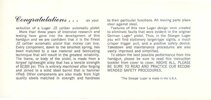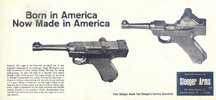NIGHTLORD40K
Member
Didnt happen to be a green cap pistol did it? I still have one of stashed around here someplace. Ive got a 1:1 scale Luger squirt gun too.I had a C96 that looks so real, they told me to leave it in my pockets in 2th grade!
Didnt happen to be a green cap pistol did it? I still have one of stashed around here someplace. Ive got a 1:1 scale Luger squirt gun too.I had a C96 that looks so real, they told me to leave it in my pockets in 2th grade!
I can’t remember the tip, but it look real. I know my dad got me that one and a CZ Scorpion. The Scorpion stayed in my bookbag!Didnt happen to be a green cap pistol did it? I still have one of stashed around here someplace. Ive got a 1:1 scale Luger squirt gun too.
Mine is a 1978 model. Mine is extremely accurate and only has problems if the chamber is not kept cleaned or if too low a velocity ammo is used......here is one page of the brochure:Hmm? Not familiar with the Erma Lugers?
Well, they were made in post WW2 Germany to cash in on the militaria craze. Erma was a supplier of German wartime guns (mostly submachine guns), but never actually part of the Luger program. Just a rough guestimate on my part, but production probably ran from the late '60s through mid-90s.
They are largely made of cast-zinc/aluminum alloy, also known as Zamak or "pot-metal." There are different grades of zinc alloys, some being very strong and durable, but the lesser grades are prone to crystalization, cracking, and even disintegration- the material gained a particularly bad rap when used on old model trains that tended to fall apart in your hands after a few years in the attic. Zinc alloys also oxidize very quickly, often aquiring powdery white corrosion on unprotected surfaces.
Because it is a quick and easy metal to pour and cast in finished shapes, it gained favor with many cheaper gun makers- Raven, Jennings, Bryco, etc. Some still use it, like Ruger for the Wrangler grip frame and Henry on their rimfire rifles.
The Germans have long had a fascination with Zamak. Rohm, RG, Weihrauch, and Erma were big on it- most everything GSG imports now is largely made of Zamak.
I have an abiding hatred of the stuff.
The Erma Lugers were some of the better attempts to make a commercial Luger knockoff. Most were .22s, but there were also .32 and .380 variants.
They even made a really nifty-looking "carbine" version.
Though they appear very similar, the Erma is an unlocked blowback, whereas the real Luger action is locked until the upper receiver recoils far enough for the toggle ears to hit the fixed frame ramps. The upper on the Erma, though a seperate (and steel) part, does not move independently of the (Zamak) gripframe.
Earlier guns had an all-steel barrel, wood grips, and a non-functional shoulder stock lug. Later production went to a 2-piece steel-lined zinc barrel and plastic grips and the lug was deleted
Even when new, these guns had a pretty spotty reputation for reliability. My Dad's example will mostly run with hotter ammo such as Minimags, but even then jams are common.
Stoeger made .22 "Lugers" during the same time period, also largely of Zamak, but using a stamped-steel toggle. They are no more reliable than the Ermas, don't look as authentic, and of generally lower quality.
View attachment 1183738
I've seen folks asking insane money for both the Erma and Stoeger, probably because they are German and LOOK like the real thing. IMO, they are fun to look and play with, but make only subpar working firearms.


Interesting, sounds like they were trying hard to emphasize how much better they were than the Erma product. I'd still take an Erma any day over the Stoeger. I will admit every Stoeger I've ever seen in the flesh looked like it was fished out of a riverbed and then run over by a train. For whatever reason, the Ermas appear to have generally been better cared for.Mine is a 1978 model. Mine is extremely accurate and only has problems if the chamber is not kept cleaned or if too low a velocity ammo is used......here is one page of the brochure:
View attachment 1183756
and here is some of its history (Stoeger Luger not the Erma Luger)
"The first Stoeger Lugers were produced in 1969 with aluminum forging/machined frames (7075 T6 aluminum). Beginning in 1980 the receiver material was changed to steel. One way to identify the frame type is by the safety selector markings. Steel frames will have a red and green painted indented spot while the aluminum frames will have raised lettering that says Fire or Safe. Use of a magnet is another way to identify the composition of the pistol frame."
Let me know if you pick up PotMetal Luger! I got $10 on it easyInteresting, sounds like they were trying hard to emphasize how much better they were than the Erma product. I'd still take an Erma any day over the Stoeger. I will admit every Stoeger I've ever seen in the flesh looked like it was fished out of a riverbed and then run over by a train. For whatever reason, the Ermas appear to have generally been better cared for.
but one source says the comment about the designer is incorrect: "That story Stoeger told in the pamphlet is unmitigated BS. Borchardt was born, lived and died in Germany. He was only in the US very briefly as a consultant for Remington while they were working on the Lee rifle for Uncle Sam. Borchardt and Luger did try to market both these toggle lock pistols in the US (Luger even chambered a P08 variant in .45 ACP and called it the "American Eagle") but they never really took off. Why? Because John Moses Browning, that's why. Nobody wanted a Rube Goldberg machine."
Borchardt immigrated with his family to the U.S. when he was 16 and lived and worked here in firearms manufacturing for a good many years before returning to Germany. Ludwig Loewe, the owner of Mauser and DWM was very interested to discuss American production methods with Borchardt, since those had tighter tolerances with less fitting.FWIW: "A frustration often reported by shooters was that the pistols were "finicky" about ammunition—that they would only function well if extra high-velocity ammunition was used. This tended to contribute to a lack of popularity, because it meant that more expensive ammunition was always required. Apparently, standard velocity ammunition did not create sufficient back pressure when the pistol was fired to fully drive back the toggle and extract the spent cartridge case—especially after firing several rounds, which tended to build up residue in the chamber. In all probability, it was the fact that the chamber of the Stoeger .22 Luger, having been manufactured in Europe, was of a size to accommodate .22 ammunition that was also manufactured in Europe, which tended to be imperceptibly smaller than US manufactured .22 ammo. The Stoeger had no problem cycling with European ammo, but standard velocity US ammo would tend to "stick" in the chamber. This effect can be remedied by having a competent gunsmith to very slightly ream (or even just polish) the chamber."
This is an interesting observation since The operating brochure that comes with it says:
View attachment 1183760
butone source says the comment about the designer is incorrect: "That story Stoeger told in the pamphlet is unmitigated BS. Borchardt was born, lived and died in Germany. He was only in the US very briefly as a consultant for Remington while they were working on the Lee rifle for Uncle Sam. Borchardt and Luger did try to market both these toggle lock pistols in the US (Luger even chambered a P08 variant in .45 ACP and called it the "American Eagle") but they never really took off. Why? Because John Moses Browning, that's why. Nobody wanted a Rube Goldberg machine."
Interesting, Zamak 2 the strongest of the Zamak alloys, has a melting point higher than aluminum . . .Just a side note. During the early and mid 90s my wife and I had a small brick and mortar gun shop located downtown Bedford, Ohio. Long before the Feds came along with the NICS background checks Bedford had their own version. They also had another law regarding gun sales. No pot metal guns. During those years guns like Bryco, Lorcin and a host of others were not to be sold. They even defined the law with melting point temperature. Dealer's cost was something like $100 USD for three or about $33.33 per gun at the time. Firing pins in the Bryco .380 guns were $1.00 each and people would dry fire them breaking the pins so I kept a stock of the pins. Remove and replace a pin takes about 5 min and I got $10 to replace pins while people waited.Couldn't sell the guns but could work on them.
Ron
Where does this stuff come from?
Hugo Borchardt came to the USA in 1860 and stayed until 1881, rising to Superintendent of Works at Pioneer Breechloading Arms, then working for Colt, Winchester, and Sharps, only returning to Europe when Sharps folded. He came back to Remington in 1890 and stayed two years.
The first American Eagle Lugers were the 1000 test trial 7.65s of 1900. Only two .45 Lugers made it to the USA for the 1907 trials, collectors say there are a very few others, maybe a total of five or six.
It is cast aluminum alloy, if I had to guess, probably A380, which is pretty good for die casting.What do you call the material that a Ruger 10/22s receiver is made out of?
You could be nice and call it cast Aluminum.....
IIRC, those melting point statutes were a rather clever workaround effort to define and ban "Saturday Night Special" type guns without actually naming them by model or pricepoint.Interesting, Zamak 2 the strongest of the Zamak alloys, has a melting point higher than aluminum . . .
Nothing personal!Wait----what?
